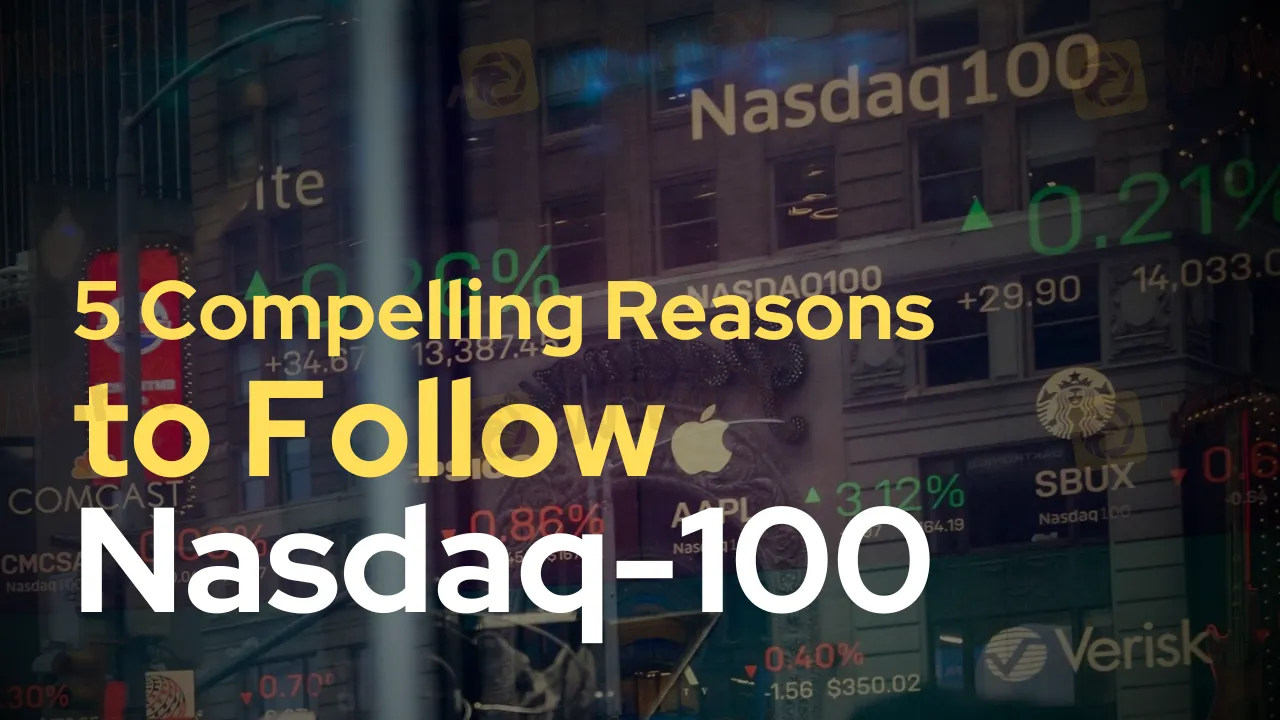简体中文
繁體中文
English
Pусский
日本語
ภาษาไทย
Tiếng Việt
Bahasa Indonesia
Español
हिन्दी
Filippiiniläinen
Français
Deutsch
Português
Türkçe
한국어
العربية
5 Compelling Reasons to Follow Nasdaq-100
Abstract:Discover the top 5 reasons to follow Nasdaq-100, from global brands and innovation to performance, dividends, and ESG commitment. Invest wisely.

In the dynamic world of stock markets, the Nasdaq-100 Index stands out as a beacon for investors seeking growth and innovation. Since its inception in 1985, the Nasdaq-100 (NDX) has carved a niche as a premier large-cap growth index, tracking 100 of the largest non-financial companies listed on the Nasdaq Stock Market. These companies are not just titans in their respective fields but also trailblazers in terms of innovation, global reach, and financial robustness. This article delves into the reasons why keeping an eye on the Nasdaq-100 is a wise move for investors of all stripes.
Top Global Brands: The Cornerstone of the Nasdaq-100
At the heart of the Nasdaq-100 are some of the world's most influential and recognized brands. Imagine a day in your life – it likely starts with a cup of coffee from Starbucks, involves using Microsoft Office for work, browsing on an iPhone, or relaxing with a Netflix show. These everyday experiences are brought to you by companies that are part of the Nasdaq-100. This index is not just a list of companies; it's a collection of innovators that touch our lives daily.

Moreover, the financial clout of these companies is formidable. In terms of market capitalization, which is the total market value of a company's outstanding shares, seven of the top ten global companies are proud members of the Nasdaq-100. This is a testament to their financial stability and investor confidence. A 2023 report by Interbrand, a leading brand consultancy, placed nine companies from the NDX among the top 20 global brands. This recognition underscores the blend of brand value and market presence that these companies command.
Leading Innovation: Pioneering Tomorrow's Technologies Today
The Nasdaq-100 is a melting pot of sectors driving the future – from Technology and Healthcare to Consumer Discretionary and Industrials. These sectors are spearheading advancements in fields as varied as autonomous vehicles, wearable technologies, and quantum computing.
Consider the impact of companies like Tesla in revolutionizing transportation, Amazon in redefining retail, and Moderna's breakthroughs in mRNA vaccine technology. These are but a few examples of the Nasdaq-100 companies that are not just participating in the innovation race but are leading it.
What's more, the Nasdaq-100 is home to giants in biotechnology and pharmaceuticals, including Amgen, Gilead Sciences, and AstraZeneca. These companies are at the forefront of medical research, developing treatments that improve and save lives. Their presence in the index highlights the Nasdaq-100's role in fostering companies that are committed to solving some of the world's most pressing health challenges.
Performance: A Track Record of Success
When comparing stock market indices, performance is a key metric, and here, the Nasdaq-100 shines brightly. Let's take a journey from December 31, 2007, to September 30, 2023. During this period, the Nasdaq-100 demonstrated remarkable strength, posting cumulative returns of an impressive 726%, far outpacing the 301% returns of the S&P 500. In simpler terms, this means that the Nasdaq-100 grew more than twice as much as the S&P 500, highlighting its potential for higher returns. What's more, with an annualized return rate of 14.3%, compared to 9.2% for the S&P 500, the Nasdaq-100 not only showed stronger growth but also did so consistently over time.
This outstanding performance can be attributed to the Nasdaq-100's heavy allocation towards growth stocks. These stocks, often from sectors like technology and healthcare, have the potential to grow faster than the broader market, making them attractive to investors looking for higher returns, despite their higher risk and volatility.
Growing Dividends: A Sign of Financial Health
Dividends, the portion of a company's profits paid out to shareholders, are a critical factor for many investors. They represent a company's financial health and its ability to generate consistent profits. While not all companies in the Nasdaq-100 pay dividends, those that do, signal financial stability and investor confidence.
Comparing dividend trends, we see an interesting picture. In 2003, the Nasdaq-100's dividend yield was a modest 0.18%, significantly lower than other indices like the S&P 500 and the Dow Jones Industrial Average. Fast forward to June 2023, and the picture has changed dramatically. The dividend yield of the Nasdaq-100 has grown to 0.84%, showcasing a significant increase and reflecting the growing financial strength of its constituent companies. This growth, although still lower than some other indices, is a positive sign for investors looking for a combination of growth and income.
ESG Commitment: Investing with a Conscience
In todays investment landscape, there's a growing emphasis on Environmental, Social, and Governance (ESG) factors. ESG investing is about making decisions that not only offer financial returns but also have a positive impact on society and the environment. The Nasdaq-100, while not a dedicated ESG index, stands out for its strong foundation in ESG principles. A staggering 93 of its companies are part of the Nasdaq-100 ESG Index, which evaluates companies based on specific ESG criteria.
This is notably higher than the representation of S&P 500 companies in their respective ESG index.
The companies within the Nasdaq-100 are setting ambitious goals for environmental sustainability, social responsibility, and ethical governance. From adopting renewable energy to championing diversity and inclusion in the workplace, these companies are not just focused on profits but also on making a positive impact on the world.
Conclusion
The Nasdaq-100 is more than just an index; it's a reflection of modern economic trends, innovative prowess, and sustainable investing. Its blend of top global brands, leadership in innovation, impressive performance, growing dividends, and commitment to ESG makes it a compelling choice for investors. Whether you are a seasoned investor or just starting, tracking the Nasdaq-100 offers a window into the world of companies shaping our future. Accessing the index through exchange-traded funds like QQQ/QQQM can be a straightforward way to tap into the potential of these leading companies. In sum, the Nasdaq-100 is not just a benchmark for financial growth but also a testament to the evolving nature of investment in a world where innovation, sustainability, and financial performance go hand in hand.

Disclaimer:
The views in this article only represent the author's personal views, and do not constitute investment advice on this platform. This platform does not guarantee the accuracy, completeness and timeliness of the information in the article, and will not be liable for any loss caused by the use of or reliance on the information in the article.
Read more

OctaFX Flagged by Malaysian Authorities
OctaFX has been officially listed on warning lists by both Bank Negara Malaysia (BNM) and the Securities Commission Malaysia (SC). These alerts raise serious concerns about the broker’s status and whether it is legally allowed to operate in Malaysia.

Why Your Worst Enemy in Trading Might Be You
Be Honest With Yourself: Are You Slowly Destroying Your Trading Account?

TradingPRO: A Closer Look at Its Licences
In an industry where safety and transparency are essential, the regulatory status of online brokers has never been more important. For traders seeking to protect their capital, ensuring that a platform operates under recognised and stringent oversight can make all the difference. Keep reading to learn more about TradingPRO and its licenses.

Oil Price Breakout Incoming? Investors Should Stay Alert
Oil prices are hovering around a critical level, with potential yet to be fully unleashed. Investors must prepare for sudden changes.
WikiFX Broker
Latest News
How much money will you earn by investing in Vantage Broker?
IronFX vs Exness Review 2025: Comprehensive Broker Comparison
Fraudsters Are Targeting Interactive Brokers' Users with Lookalike Emails
Interactive Brokers: Global Office Visits and Licensing Details
Top Tips to Choose the Best Forex Broker in 2025
SEBI Notifies New F&O Rules for Investors - New Derivative Trading Limits & More Amendments
U.S. Jobs Data Released: A Potential Boost for Gold Prices
SkyLine Guide 2025 Malaysia: 100 Esteemed Judges Successfully Assembled
Everything you need to know about ADSS
Vantage Markets Review 2025: Trusted Forex and CFD Trading Since 2009
Currency Calculator


